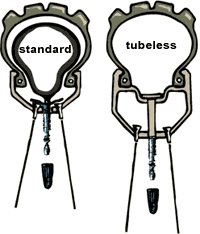Every city cyclist has had the bad luck of springing multiple flats in one month, one week, or even within the same day. Tubeless tires have been easing into the cyclocross circuit, with more and more riders abandoning conventional tubular rigs for tubeless tires. Traditional tubular tires still reign supreme in the top levels of cyclocross racing because they boast a wealth of advantages: The wheels are lighter, the casings tend to be more supple, and they do a better job of conforming to the terrain. However, since dynamic performance is not always the main focus for the average joe, tubeless rigs might be an idea worth entertaining for city bike commuters. They require no tube pinching and running sealant is often enough to repair small punctures, meaning less visits to the shop!
A tubeless setup consists of a tube and a rim that are specifically manufactured for one another. The physical interlocking of the two pieces is nearly the only thing holding the system together, and as such, it’s all about fit and the quality of the interface between the rim and the tire. The tighter, the better.
GOOD SIGNS: distinctive ‘pops’ when the beat seats onto the rim, the tire inflates easily with a floor pump, the tire is still difficult to remove, even when deflated
The chief advantage of tubeless tires is their ability to run on lower pressures with a minimal risk of flatting, even on an extremely bumpy, dangerous city commute. So long as the rim and tire fit tightly, there is little to no risk of rolling, as well.
There are a couple of downsides. Firstly, there is a limited selection of tubeless rims on the market , and fewer still actual tires. Wheels and rims are available from from Stan’s NoTubes, Shimano, Easton, Bontrager, and Campagnolo/Fulcrum. Vittoria, Kenda, and Hutchinson have tubeless-ready tires, though Hutchinson is the only brand with tires wider than 23mm.
Secondly, working with tubeless road tires is decidedly more difficult than normal tubular rigs- it’s not as simple as handling a regular clincher. Upkeep of the stiff beads on and off of rims often requires soapy water and a bit of finagling. Being that the balance of tire and rim tread is so delicate, you must be careful in your choice of tire levers and the sealant used to repair punctures, as well as the installation of valves, rim tape, and strips. In some cases, an air compressor may be needed to properly install the tires.
Overall, setup and maintenance can be harder than normal though typically not as frequent, and tubeless setups require a little more vigilance than tubular setups. However, the buttery smooth ride and enhanced traction of running at lower pressures may be well worth the hassle.

Leave a Reply